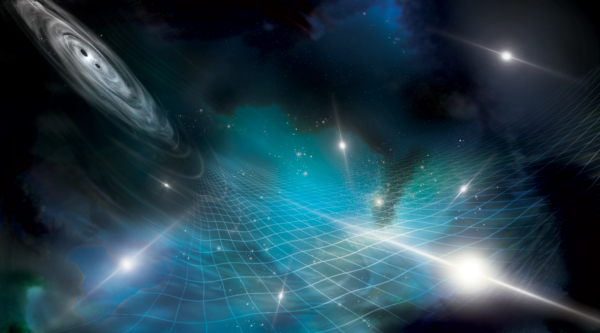AUI will present at the 247th meeting of the American Astronomical Society in Phoenix from January 4-8.
Recent News
ALMA Helps Unmask Monster Black Hole Behind Record-Breaking Cosmic Burst
Astronomers have used the Atacama Large Millimeter/submillimeter Array (ALMA) together with a suite of space- and ground-based telescopes, to study AT 2024wpp, the most luminous fast blue optical transient (LFBOT) ever observed.
Astronomers Make First Radio Detection of Rare Supernova Type, Revealing Secrets of Stellar Death
Astronomers using the U.S. National Science Foundation Very Large Array have captured the first-ever radio signals from a rare class of stellar explosion known as a Type Ibn supernova.
Scientists use Exotic Stars to Tune into Hum from Cosmic Symphony

Credit: A. Simonnet (NANOGrav)
For the last 15 years, the North American Nanohertz Observatory for Gravitational Waves (NANOGrav) Physics Frontiers Center has been using radio telescopes supported by the National Science Foundation— including those operated by NSF’s National Radio Astronomy Observatory— to turn a suite of millisecond pulsars into a galaxy-scale gravitational-wave detector. Millisecond pulsars are remnants of extinguished massive stars; as they spin hundreds of times each second, their “lighthouse-like” radio beams are seen as highly regular pulses. Gravitational waves stretch and squeeze space and time in a characteristic pattern, causing changes in the intervals between these pulses that are correlated across all the pulsars being observed. These correlated changes are the specific signal that NANOGrav has been working to detect.
NANOGrav’s most recent dataset offers compelling evidence for gravitational waves with oscillations of years to decades. These waves are thought to arise from orbiting pairs of the most massive black holes throughout the Universe: billions of times more massive than the Sun, with sizes larger than the distance between the Earth and the Sun. Future studies of this signal will enable us to view the gravitational-wave universe through a new window, providing insight into titanic black holes merging in the hearts of distant galaxies and potentially other exotic sources of low-frequency gravitational waves.
Read the full press release from NANOGrav.
A public event discussing the results will take place on Thursday, June 29, 2023 at 1pm Eastern Time on YouTube Live.
This news article was originally published on the NRAO website on June 28, 2023.
Recent News
AUI to Attend AAS 247 Conference
AUI will present at the 247th meeting of the American Astronomical Society in Phoenix from January 4-8.
ALMA Helps Unmask Monster Black Hole Behind Record-Breaking Cosmic Burst
Astronomers have used the Atacama Large Millimeter/submillimeter Array (ALMA) together with a suite of space- and ground-based telescopes, to study AT 2024wpp, the most luminous fast blue optical transient (LFBOT) ever observed.
Astronomers Make First Radio Detection of Rare Supernova Type, Revealing Secrets of Stellar Death
Astronomers using the U.S. National Science Foundation Very Large Array have captured the first-ever radio signals from a rare class of stellar explosion known as a Type Ibn supernova.
